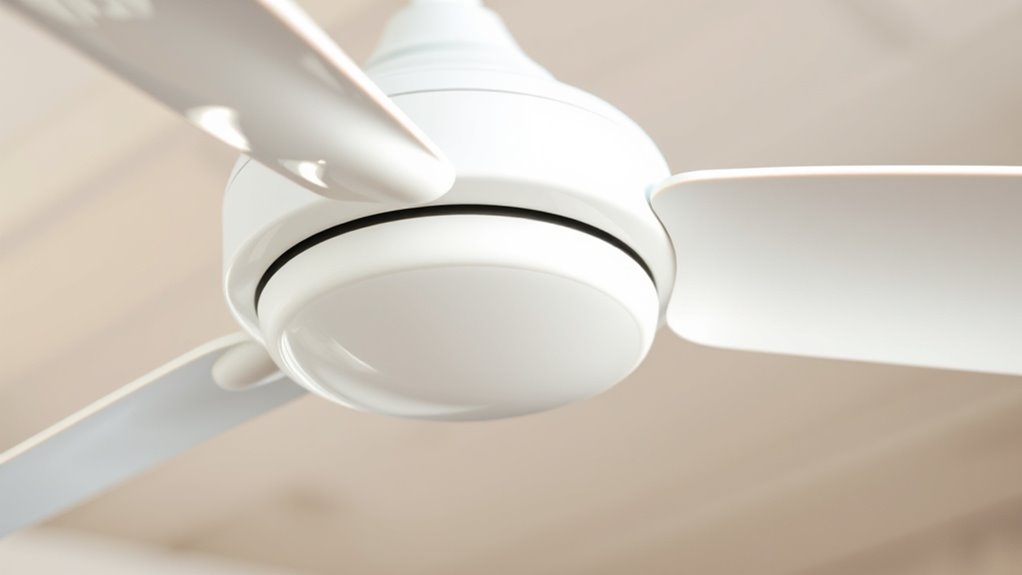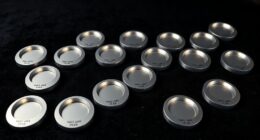To prevent dust buildup on ceiling fan blades, clean them regularly—biweekly wiping with microfiber cloths or dusters helps remove dust before it accumulates. Use extendable tools for hard-to-reach areas, and dampen cloths lightly to tackle stubborn dirt. Keep windows and vents closed during windy days and install filters to reduce airborne dust. Applying protective products like blade conditioners can also make cleaning easier over time. Continue exploring effective tips to maintain a dust-free, efficient fan longer.
Key Takeaways
- Regularly wipe blades with microfiber cloths or dusting tools to prevent dust accumulation.
- Use pillowcases or extendable microfiber dusters to safely capture dust from fan blades.
- Keep windows and vents closed during windy days to reduce dust settling on blades.
- Apply protective coatings like furniture polish designed for ceiling fans to repel dust.
- Minimize indoor dust sources by controlling furniture, curtains, and maintaining a clean environment.

Dust buildup on ceiling fan blades is a common issue that can reduce airflow efficiency and spread allergens throughout your home. If you notice that your fan isn’t circulating air as effectively or you find a layer of dust on the blades, it’s time to take proactive steps to prevent future accumulation. Regular maintenance and strategic habits can keep your ceiling fan clean, efficient, and allergen-free.
First, establish a routine cleaning schedule. Wiping down the blades every couple of weeks with a microfiber cloth or a dusting tool can prevent excessive dust from settling. Use a gentle, lint-free cloth to avoid leaving behind fibers that can attract more dust. For stubborn dirt or grime, lightly dampen the cloth with water or a mild cleaning solution, but ensure the blades are completely dry afterward to prevent warping or corrosion. When cleaning, pay attention to the edges and corners of the blades, which are often overlooked but tend to accumulate dust more quickly.
Establish a routine of biweekly dusting with microfiber cloths to prevent buildup and maintain airflow efficiency.
To make cleaning easier and more effective, consider using a pillowcase or a specialized ceiling fan duster. Sliding a pillowcase over the blades and gently pulling it back traps dust inside, reducing mess and preventing dust from falling onto furniture or floors. An extendable duster with a microfiber cover can reach high or awkwardly positioned fans without the need for a ladder, making routine cleaning safer and more efficient. Regular dusting not only keeps blades cleaner longer but also reduces the amount of dust that circulates in the air, improving indoor air quality.
Another key strategy involves controlling dust sources around your home. Keep windows and vents closed during windy days or when sweeping, to prevent dust from drifting onto your ceiling fan blades. Use high-efficiency particulate air (HEPA) filters in your HVAC system to trap airborne dust particles, decreasing the overall dust load in your environment. Additionally, reduce clutter and dust-collecting items in your living space, such as fabric curtains or plush furniture, which can harbor dust mites and allergens. Maintaining a dust-free environment contributes significantly to the longevity of your fan blades and overall indoor air quality.
Finally, consider applying a light coat of furniture polish or a specialized blade conditioner designed for ceiling fans. These products can create a protective barrier that repels dust and makes subsequent cleaning easier. Always follow the manufacturer’s instructions when applying such products to avoid damaging the blades. By combining these habits—regular cleaning, dust source control, and protective treatments—you can remarkably reduce dust buildup on your ceiling fan blades, maintaining ideal airflow and promoting a healthier indoor environment.
Frequently Asked Questions
How Often Should I Clean My Ceiling Fan Blades?
You should clean your ceiling fan blades every two to four weeks to keep dust from accumulating. Regular cleaning prevents dust buildup, which can reduce airflow and air quality. Use a microfiber cloth or a damp cloth with mild detergent to wipe each blade thoroughly. If you notice more dust or allergens, clean more frequently. Always turn off the fan and ensure blades are dry before turning it back on for safety.
Are There Eco-Friendly Dust Prevention Methods for Fans?
Think of eco-friendly dust prevention like a gentle rain that keeps your home clean. You can use natural methods such as placing activated charcoal or baking soda near your fan to absorb airborne dust. Regularly wiping blades with a damp microfiber cloth helps reduce dust buildup without chemicals. Additionally, increasing ventilation and using air purifiers with HEPA filters can trap dust particles, keeping your fan cleaner longer and reducing the need for frequent cleaning.
Can Certain Types of Paint Reduce Dust Accumulation?
Using certain types of paint, like semi-gloss or high-gloss finishes, can help reduce dust buildup on ceiling fan blades. These paints create a smooth, non-porous surface that dust and dirt find harder to stick to. You should clean the blades regularly with a damp cloth to maintain their smoothness. Applying a fresh coat every few years can also enhance the dust-resistant effect and keep your fan cleaner longer.
Does Humidity Level Affect Dust Buildup on Fan Blades?
Sure, humidity levels do influence dust buildup on fan blades. When the air’s moist, dust particles cling more stubbornly, turning your fan into a dusty sculpture. Keep humidity below 50% to minimize this, and consider using a dehumidifier or air conditioner. Regularly wiping blades with a microfiber cloth also helps. Staying dry and vigilant ensures your ceiling fan stays cleaner longer, avoiding the dreaded dust accumulation disaster.
Are There Specific Cleaning Tools Best for Ceiling Fan Blades?
You should use microfiber cloths or dusting mitts for ceiling fan blades because they trap dust effectively without scratching surfaces. A step ladder helps reach high blades safely. For stubborn grime, dip the cloth in a mixture of water and a small amount of mild detergent or use a ceiling fan cleaning kit with extendable handles. Always turn off the fan before cleaning to prevent accidents.
Conclusion
By regularly cleaning your ceiling fan blades and using dust-repellent treatments, you keep dust from settling like unwanted guests at a party. Simple habits like wiping blades with a microfiber cloth weekly and installing dust covers can make a significant difference. Think of your fan as a well-tended garden—consistent care prevents clutter from taking root, ensuring efficient airflow and a cleaner home. With these practical steps, dust won’t have a chance to take hold and turn your fan into a magnet.








